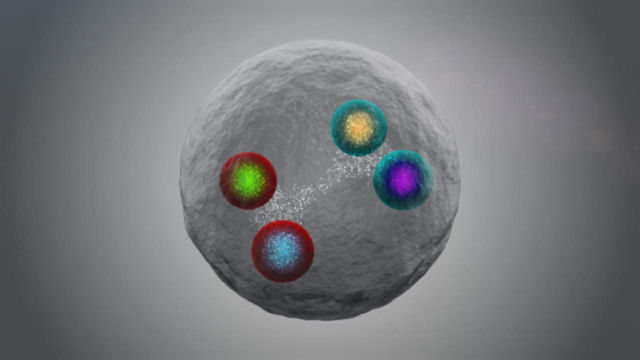The LHCb collaboration at CERN has observed for the first time an exotic particle made up of four charm quarks.
The LHCb collaboration has observed a type of four-quark particle never seen before. The discovery, presented at a recent seminar at CERN and described in a paper posted today on the arXiv preprint server, is likely to be the first of a previously undiscovered class of particles.
Illustration of a tetraquark composed of two charm quarks and two charm antiquarks, detected for the first time by the LHCb collaboration at CERN. Credit CERN
The finding will help physicists better understand the complex ways in which quarks bind themselves together into composite particles such as the ubiquitous protons and neutrons that are found inside atomic nuclei.
Quarks typically combine together in groups of twos and threes to form particles called hadrons. For decades, however, theorists have predicted the existence of four-quark and five-quark hadrons, which are sometimes described as tetraquarks and pentaquarks, and in recent years experiments including LHCb have confirmed the existence of several of these exotic hadrons. These particles made of unusual combinations of quarks are an ideal “laboratory” for studying one of the four known fundamental forces of nature, the strong interaction that binds protons, neutrons and the atomic nuclei that make up matter. Detailed knowledge of the strong interaction is also essential for determining whether new, unexpected processes are a sign of new physics or just standard physics.
“Particles made up of four quarks are already exotic, and the one we have just discovered is the first to be made up of four heavy quarks of the same type, specifically two charm quarks and two charm antiquarks,” says the outgoing spokesperson of the LHCb collaboration, Giovanni Passaleva. “Up until now, LHCb and other experiments had only observed tetraquarks with two heavy quarks at most and none with more than two quarks of the same type.”
“These exotic heavy particles provide extreme and yet theoretically fairly simple cases with which to test models that can then be used to explain the nature of ordinary matter particles, like protons or neutrons. It is therefore very exciting to see them appear in collisions at the LHC for the first time,” explains the incoming LHCb spokesperson, Chris Parkes.
source CERN






Leave A Comment